Marcus P. Corrosion mechanisms in theory and practice
Подождите немного. Документ загружается.

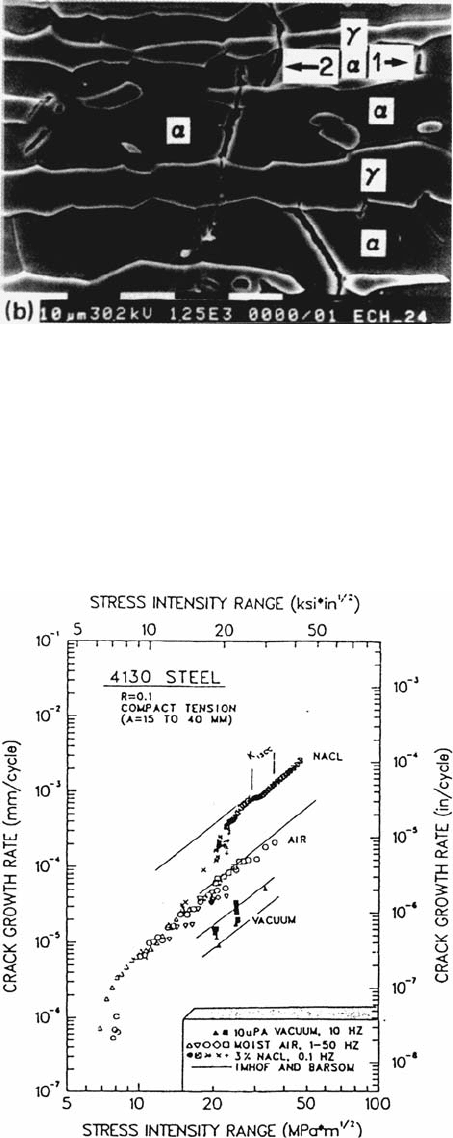
typical characteristics of the corrosion fatigue behavior are given in Figure 13 as
a function of the stress intensity factor ΔK. Interactions with SCC are emphasized.
The models then propose that the rate of crack growth corresponds either to
the sum of pure mechanical fatigue and the rate of stress corrosion cracking or to the
462 Magnin
Figure 11. (Continued).
Figure 12 Influence of environment on the crack propagation velocity for a 4130 steel [4].
Copyright © 2002 Marcel Dekker, Inc.

fastest available mechanisms among those described in the following. Figure 14
summarizes the influence of corrosion on the fatigue crack growth characteristics
[13–15]. To the purely mechanistic mode I crack propagation behavior under
vacuum (curve 1) must be added (a) the effect of closure [4,6] and mode II on the
near-threshold (curve 2), (b) the hydrogen-assisted crack propagation behavior
(curve 3), and (c) the influence of absorption and diffusion of hydrogen at low
loading R ratio (curve 4) and at higher R ratio (curve 5). One must also take into
account dissolution and film effects.
However, it has been shown that short cracks propagate at stress intensity
factors well below the long crack threshold, as shown in Figure 15 for carbon steel
in seawater.
The application of microstructural fracture mechanisms (MFMs) has been
successfully used to predict the growth of short cracks during fatigue in air [16].
These models have been adapted to characterize and predict the uniaxial and
multiaxial corrosion fatigue loading [17].
The two following equations provide the basis of the Brown-Hobson model
[18], in which the fatigue crack growth rate is expressed as a function of an
equivalent strain term γ
eq
for stage I and stage II cracks, respectively.
Corrosion Fatigue Mechanisms 463
Figure 13 Schematic of fatigue and corrosion fatigue crack growth rate as a function of
crack tip stress intensity.
Copyright © 2002 Marcel Dekker, Inc.
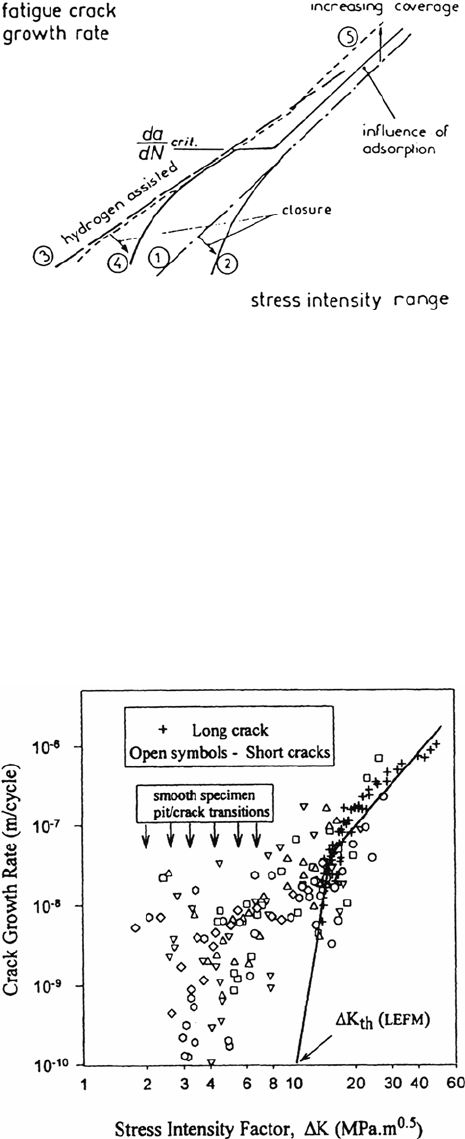
464 Magnin
Figure 14 Schematization of the different CF crack growth mechanisms [13].
Figure 15 Comparison of long and short CF crack growth rates for carbon steels (σ
y
= 500
MPa) in artificial water, 0.2 Hz, R = 0.1 [15].
where a is the crack length; d a microstructural parameter such as grain size; i the
number of grains through which the crack has traversed; B
I
, B
II
and β
I
, β
II
are
constant depending upon the material-environment system; and D is the long
crack threshold.
The determination of the crack tip environment is not easy because of the
numerous electrochemical reactions and the associated mass transport and
thermodynamic criteria that govern this environment. The nature of the solution
(composition, pH, species, corrosion products that can induce roughness, etc.) can
Copyright © 2002 Marcel Dekker, Inc.
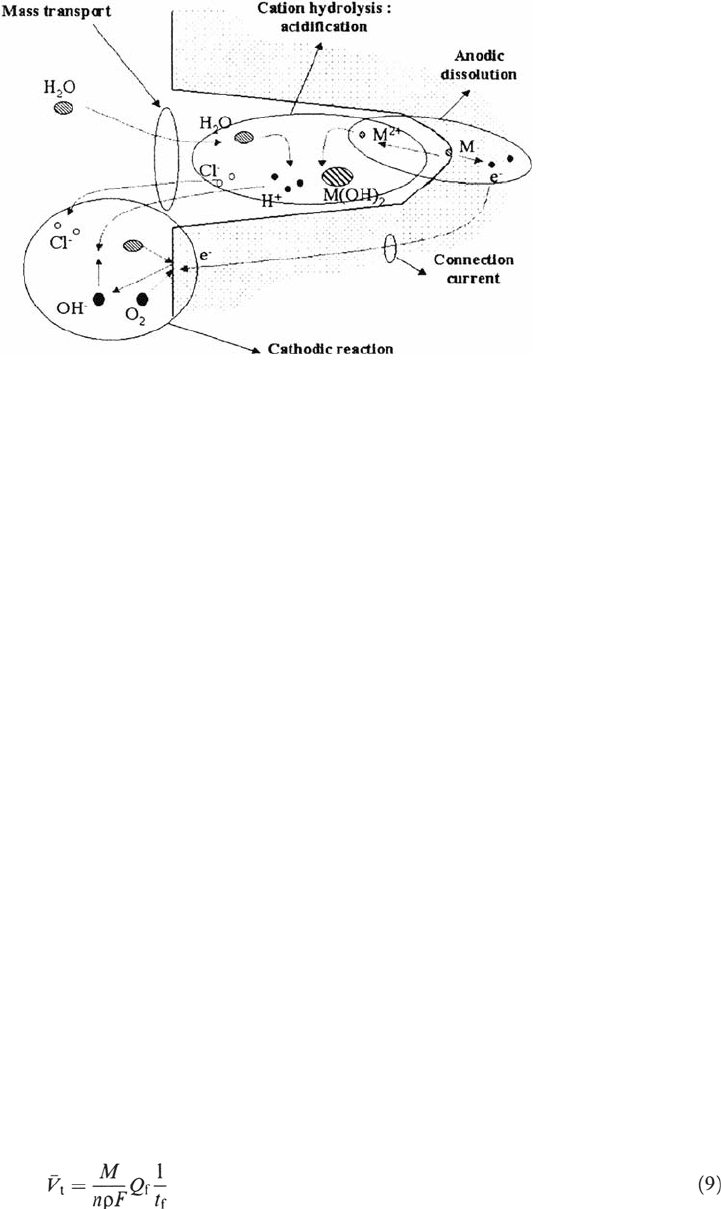
be very different at the crack tip and in the bulk solution. Figure 16 shows the
possible electrochemical reactions at the crack tip. Both anodic dissolution effects
and a coupled hydrogen reaction must often be taken into account. The mathematical
modeling of the localized crack tip chemistry is therefore possible [19].
One can find in Ref. 20 a very significant effect of the transport properties
of the crack solution on the CF crack growth rates of steel in seawater.
Anodic Dissolution Effects
Anodic dissolution has been shown to occur preferentially in slip bands [11] very
near the crack tip, which leads to many effects on the CF behavior as shown in
Figure 17. A restricted slip reversibility model for stage I fatigue crack propagation
has been proposed. The average crack growth increment per cycle, Δ
χ,
is determined
by factors controlling slip reversibility on the forward slip planes (i.e., S1 and S4).
For fcc materials, it involves alternating slip on (111) planes near the crack tip.
The slip reversibility is controlled by the degree of work hardening and recovery
on a slip plane and the presence of corrosion products (oxides) on the slip steps.
The rate of hydrated oxide nucleation plays a critical role in this model and therefore
is expected to control stage I fatigue crack growth of an austenitic stainless steel
in Cl
–
solutions.
This localized dissolution process is not easy to take into account in numerical
modeling of crack propagation. The slip dissolution model for CF is based on the
fact that for many alloys in different solutions the crack propagation rate is
proportional to the oxidation kinetics. Thus, by invoking Faraday’s law, the average
environmentally controlled crack propagation rate V
–
t
for passive alloys is related
to oxidation charge density passed between film rupture events, Q
f
:
Corrosion Fatigue Mechanisms 465
Figure 16 Possible electrochemical reactions at a corrosion fatigue crack tip.
Copyright © 2002 Marcel Dekker, Inc.
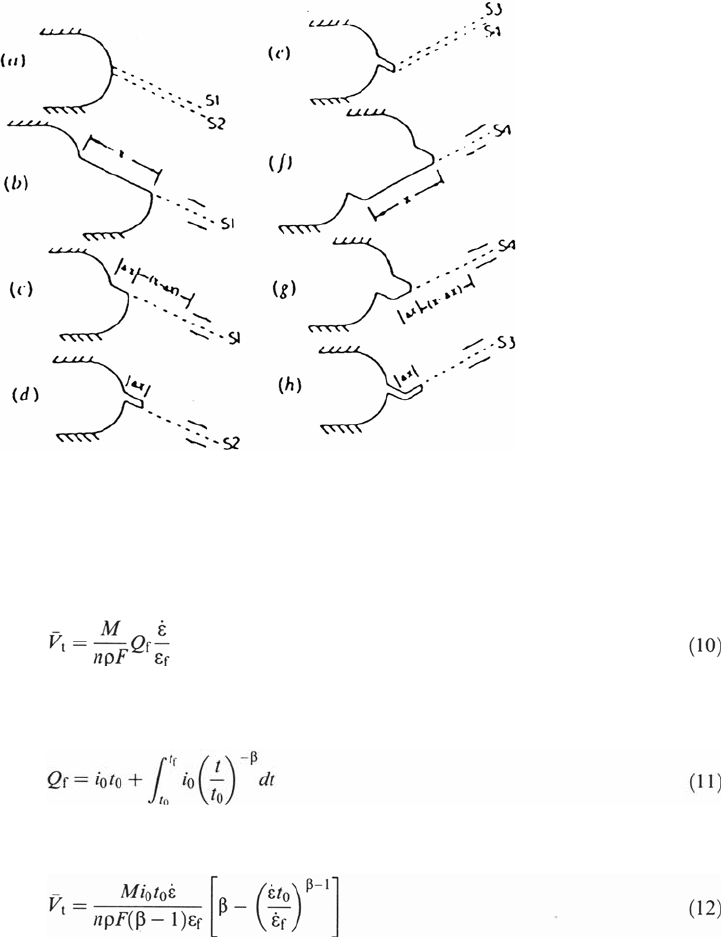
where t
f
is the film rupture period. Thus:
466 Magnin
Figure 17 Schematic diagram of stage I corrosion fatigue crack propagation
mechanism [21].
where ε
·
is the strain rate and ε
f
the strain for film rupture (about 10
–3
).
If we take a classical law for current transients at the crack tip,
Then, for t
f
> t
0
, β > 0,
Even if mechanical analyses give good approximations for ε
·
at the crack tip, some
problems still remain with the previous equation. In particular, the value of
β evolves all along cycling. But the main effect is related to the localized corrosion-
deformation described previously. It has been shown that vacancy generation at
the crack tip due to localized dissolution can induce cyclic softening effects and
that hydrogen absorption, which can also be coupled to localized dissolution, can
also enhance the local cyclic plasticity. This is why improvement of CF predictive
laws is needed even if V
t
can be adjusted in the equation, which is still very useful.
New models based on the description of Figure 17 but taking into account the
localized corrosion deformation processes are under study.
Copyright © 2002 Marcel Dekker, Inc.
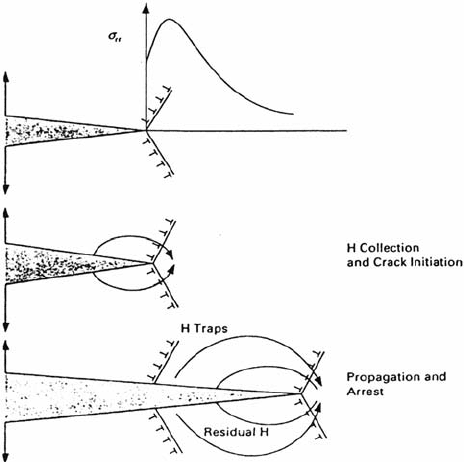
Moreover, films related to solid-state oxidation (M + H
2
O→MO + 2H
+
+
2e
–
) can also play a role in the crack advance. This needs further studies to be
quantitatively more relevant [22].
Hydrogen Effects
Hydrogen-assisted cracking is often invoked, particularly for body-centered
cubic (bcc) materials but also together with anodic dissolution for fcc alloys.
Figure 18 shows schematically a hydrogen-assisted cracking event. Interactions
between a discretized dislocation array and the crack tip under an applied stress
produce a maximum stress field from behind the tip. When the hydrogen con-
centration reaches a critical value, a microcrack is nucleated because either the
local cohesive strength is reduced or dislocation motion is blocked in the
hydrogen-enriched zone, or both. The microcrack arrests about 1 μm ahead of
the original location of the tip and these processes then repeat, leading to
discontinuous microcracking.
Other mechanisms have been proposed, particularly the hydrogen-induced
plasticity model for precipitates containing materials such as Al-Zn-Mg alloys.
This model is shown in Figure 19 [5].
Absorbed hydrogen atoms weaken interactomic bonds at the crack tip and
thereby facilitate the injection of dislocations (alternate slip) from the crack tip. Crack
growth occurs by alternate slip at crack tips, which promotes the coalescence of
cracks with small voids nucleated just ahead of the cracks. In comparison with the
behavior in neutral environments, the CF crack growth resistance decreases as the
Corrosion Fatigue Mechanisms 467
Figure 18 Schematic illustration of hydrogen-assisted cracking mechanism [22].
Copyright © 2002 Marcel Dekker, Inc.
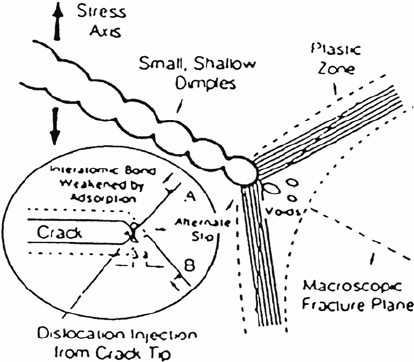
proportion of dislocation injection to dislocation egress increases. More closely
spaced void nuclei and lower void nucleation strains should also decrease the
resistance to crack growth in CF. This mechanism is proposed for Al-Zn-Mg alloys
and is highly supported by observations that environmentally assisted cracking can
occur at high crack velocities in materials with low hydrogen diffusivities and that
the characteristics of cracking at high and low velocities are similar.
Other hydrogen-dislocation interactions at the corrosion fatigue crack tip
must be taken into account. One can show, for instance, that hydrogen promotes
planar slip in fcc materials. Cross-slip ability can be discussed for the peculiar
situation of the dissociation of a perfect screw dislocation into two mixed partials
separated by a stacking fault ribbon (Fig. 20). The cross-slip probability depends
on the work necessary for recombination.
Each partial is subjected to two forces: the repulsion due to the other partial
and the attraction due to the stacking fault (Γ ~
–
100 mJ/m
2
in nickel, for instance).
In the absence of an external stress, the partials are in equilibrium at a distance
where the two forces annihilate.
Hydrogen interacts only with the edge parts of the partials (hydrostatic
stresses). It migrates to the tensile zone of the edge parts, as shown in Figure 20
from an initial concentration C
0
(for calculations, see Ref. 23).
The dilatation strains due to the antisymmetric hydrogen distribution induce a
net shear component along the dislocation line, whose sign is opposed to that of the
edge dislocation. Because the Burger’s vectors of the two edge parts of the partials
have opposite sign, hydrogen segregation will induce a supplementary effect, which
is to reduce their normal attraction. From the viewpoint of the mixed partials, the
repulsion between the screw parts is the leading term, and hydrogen induces a
supplementary repulsion by “screening” the attraction between the edge components.
This screening of the pair interactions between coplanar edge dislocations was
shown to be independent to the first order on the distance between dislocations [23],
provided that diffusion time and temperature allowed the hydrogen distribution to
468 Magnin
Figure 19 Schematization of the hydrogen-induced plasticity model for CF cleavage like
cracking [5].
Copyright © 2002 Marcel Dekker, Inc.
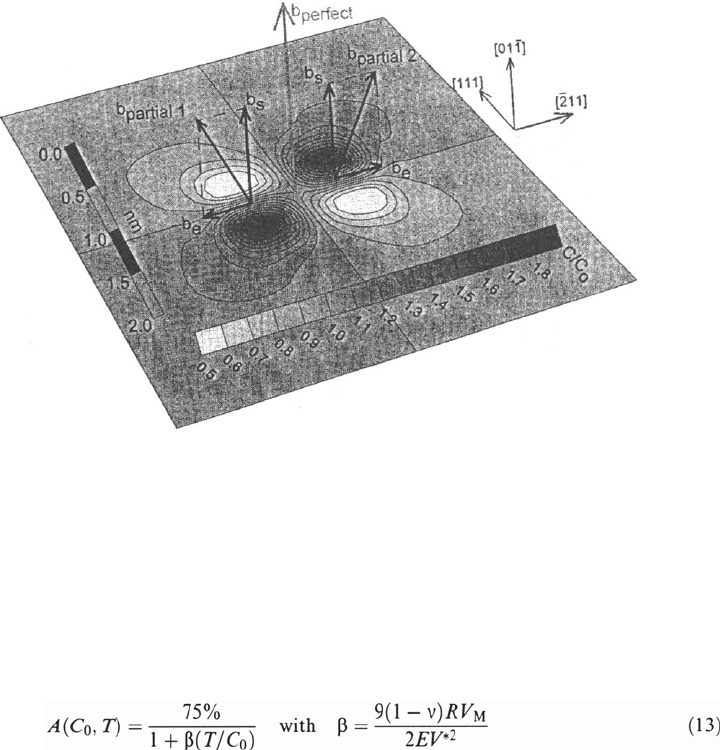
reach a configuration “in equilibrium with the local stress.” Under these conditions,
the relative screening of the pair interactions (i.e., the “hydrogen component” of
the resolved shear stress normalized by that of the dislocation itself) was shown
by numerical simulations to be given with excellent accuracy by the following
simple expression [23]:
Corrosion Fatigue Mechanisms 469
Figure 20 Equilibrium hydrogen distribution around a dissociated screw dislocation in
nickel (C
0
is the initial concentration of hydrogen).
where C
0
is the remote hydrogen concentration (in atom fraction); T is the absolute
temperature; R is the gas constant; E, v, and V
M
are Young’s modulus, Poisson’s
ratio, and the molar volume of the host metal; and V
*
is the hydrogen partial molar
volume. The coefficient β contains all the material parameters that influence the
hydrogen screening effect as a function of temperature and concentration. In nickel,
β = 2.34 × 10
–4
K
–1
. Using this expression for the dissociated configuration of
Figure 20, Figure 21 shows the forces on one partial versus the width of the stacking
fault ribbon in nickel for an initial amount of hydrogen n
H
/n
Ni
= 0.05 at room
temperature. The d
0
and d
H
are respectively, the equilibrium distances in the
absence and in the presence of hydrogen, neglecting a possible decrease of Γ.
The recombination work is represented by the hatched areas between the curves.
In the presence of hydrogen at concentration C = 0.05, calculations show that the
recombination work is increased by 50%. The elastic effect of hydrogen is to increase
the recombination work and then to decrease the cross-slip ability. This confirms
experimental studies that show that hydrogen promotes planar glide [24].
Finally, it must be said that very often anodic dissolution and hydrogen
effects must both be taken into account.
Copyright © 2002 Marcel Dekker, Inc.
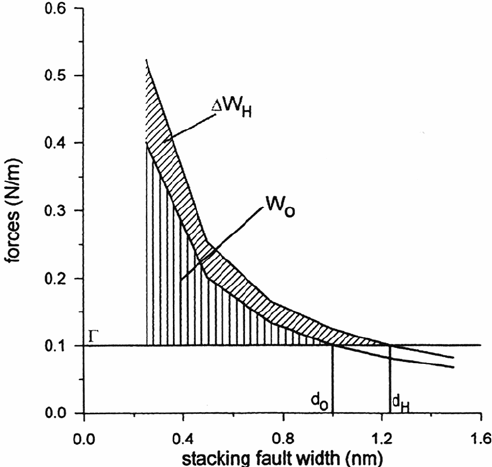
MONTE CARLO-TYPE SIMULATIONS OF CORROSION FATIGUE
LIFETIMES FROM THE EVOLUTION OF SHORT SURFACE CRACKS
Introduction
The modeling of fatigue and corrosion fatigue damage is still not completely
solved. Its definition is controversial, and it depends on the scale of interest in the
study. The high-cycle fatigue regime was first investigated, and it has been summed
up as due to the propagation from scratch of a single crack leading eventually to
fracture [25,26]. Hence, an equivalence between the level of damage and the
fatigue crack depth was considered [27]. In this case, fatigue damage accumulation
corresponds to the bulk growth rate of one crack. Those speculations have proved
to be both successful and satisfactory.
The next step aimed at extending the latter definitions from high- to low-cycle
fatigue. However, as multiple cracks nucleate and propagate simultaneously in low-
cycle fatigue, the previous definitions of both fatigue damage and fatigue damage
accumulation are ambiguous. The majority of cracks are comparable to each other
from a surface length viewpoint. Moreover, all crack lengths are comparable to
grain size throughout all the fatigue lives.
On the one hand, the mechanical approach describes the behavior of long
through-cracks in a macroscopically elastic field [7,25]. It has given interesting
empirical laws but is unable to take into account the physical processes of fatigue
damage. On the other hand, the microscopic approach was developed with the
analysis of the dislocation behavior, the corresponding strain hardening or softening
effects, and the formation of persistent and intense slip bands [28,29]. Nevertheless,
470 Magnin
Figure 21 Effect of hydrogen on the work of recombination of partials in nickel at 300 K.
Copyright © 2002 Marcel Dekker, Inc.
this approach is generally limited to the formation of the first microcracks: the
corresponding physical and numerical models concern only the first 10% of the
fatigue lifetime for polycrystalline materials. Moreover, when applied to crack
propagation, the microscopic approach does not take into account the influences
of other formed cracks. Thus, the classical mechanical and microscopic approaches
cannot be used to model the evolution of a population of surface cracks and the
corresponding low-cycle fatigue damage.
In this section an investigation of the fatigue damage process at an intermediate
scale (i.e., a mesoscopic scale corresponding to the grain size) is addressed. The
importance of the latter scale to modeling low-cycle fatigue lifetimes is pointed out
through the physical analysis of fatigue damage and of fatigue damage accumulation.
Particular attention is paid to the evolution of populations of surface short cracks.
Experimental results mainly correspond to push-pull low-cycle fatigue tests of 316L
stainless steel in air and in 3% NaCl solutions. From these results and from
assumptions concerning surface short crack behavior, a numerical model is developed.
Monte Carlo principles are used to deal with random crack nucleation and crack
interactions. It is finally shown that such an analysis is very relevant to prediction
of corrosion fatigue lifetimes of austenitic stainless steels in chloride solutions.
Physical Description of the Fatigue Damage
The experimental results on the low-cycle fatigue damage of 316L stainless steel
have been fully discussed elsewhere [30,31]. Transgranular cracking is generally
observed in the 316L polycrystalline stainless steel for fully reversed push-pull
tests at intermediate plastic deformation amplitudes (Δε
p
/2 in the range [5 × 10
–5
,
5 × 10
–3
], the plastic deformation rate being 10
–3
s
–1
).
Multiple short cracks are observed at the specimen surface. Different surface
short crack types are introduced according to both cracking behavior and surface
lengths. Surface short cracks, the lengths of which are less than one grain size (i.e.,
less than 50 μm, which is the average grain size in the case of classical 316 alloy),
are the more numerous ones. Every crack propagates first crystallographically, i.e.,
within the intense slip bands. The first main obstacles to their propagation are the
grain boundaries. The closer to the grain boundary, the lower the crack growth rate
[30,32]. Once the grain boundary is crossed, the propagation speeds up to the next
grain boundary. It has been observed experimentally that two to three grain
boundaries need to be crossed for the change of cracking behavior to take place.
Surface crack propagation evolves from crystallographic to “mechanical”
growth. The surface cracks are then observed to grow perpendicular to the specimen
axis (likely to be related to the onset of the so-called stage II cracking). The preceding
cracking process leads to distinction of three main categories of surface short cracks.
Type I cracks have a surface length less than one grain size. Type II cracks are
longer than one grain size at the surface but smaller than three (two to three grain
boundaries have been overcome by the surface short crack). Type III crack surface
length goes from 3 up to 10 grain sizes. A fourth type concerns cracks longer than 10
grain sizes at the surface. The latter cracks are numbered in the range 1 to 3 per
specimen and form during the last 10% of the fatigue lifetime, following completion
of N
i
cycles. N
i
corresponds to the number of cycles to form the type IV short crack.
It is about 90% of the fatigue lifetime [30,31].
Corrosion Fatigue Mechanisms 471
Copyright © 2002 Marcel Dekker, Inc.
